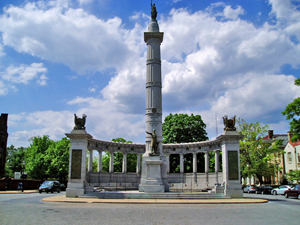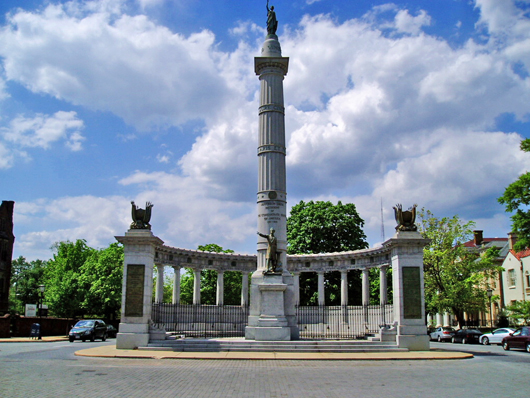
While this year’s 150th anniversary observances in Richmond and across the South take a more objective, realistic look at the war, its causes and its consequences, there are reminders aplenty that old times are not forgotten.
Charles Bryan, the president and chief executive officer-emeritus of the Virginia Historical Society, said the perspective in Virginia and elsewhere across Dixie toward the Civil War is much more mature and evenhanded in its sesquicentennial commemorations.
“The centennial in the South was basically a glorification of the Confederacy,” Bryan said. “There was no African-American participation in the centennial to speak of.”
Then, in this city of massive monuments to such Confederate heroes as J.E.B. Stuart, Thomas J. “Stonewall” Jackson and Robert E. Lee, “Yankee” was still a derisive term.
And now?
Workers last week carefully muscled a 900-pound bronze sculpture titled Brothers into place in the state Capitol’s extension just beneath the 200-year-old legislative chambers where the Confederate Congress held its first Virginia meeting 150 years ago Wednesday.
The sculpture by Pennsylvania artist Gary Casteel depicts a tearful battlefield reunion of sibling soldiers—one rebel, the other Union. The presentation is more allegorical than historical, said Capitol historian and tour supervisor Mark K. Greenough. But its meaning, he said, is clear: reconciliation.
“Maybe there’s a message in that for our modern generation,” Greenough said.
From the Civil War’s aftermath through Reconstruction, firsthand memories of its widespread death, privations and heartbreak were too fresh for romanticized notions of it to take hold, Bryan said. That didn’t happen, he said, until the early 20th century, when Margaret Mitchell’s Gone With the Wind and the film Birth of a Nation helped nurture a sanitized, glorified popular fiction about the war and the South’s sympathetic “Lost Cause.”
“I think it probably closed our minds in the South—not everybody, obviously—to the need for change and the need to embrace new ideas,” Bryan said of an era that put the legacy of slavery, Jim Crow, on a collision course with the civil rights movement. “It may have led to a certain mindset that, ‘by God, we’re not going to change.’ In some ways, that’s good, but in some ways it leaves a region and a people behind.”
And slow though change may be, Richmond itself has produced poignant and even striking examples of it.
On Capitol Square, an obscure bronze plaque in the shadow of a massive equestrian statue of George Washington marks the spot where Jefferson Davis was sworn in as the Confederacy’s lone president. About 100 yards away, at the north entrance to the Capitol, L. Douglas Wilder, a grandson of slaves, took his oath of office as the nation’s first elected black governor.
A building just downhill from the Capitol is named for Oliver Hill, the black Richmond lawyer who was lead counsel in a case later known as Brown v. Board of Education, the U.S. Supreme Court’s ruling that struck down racially segregated public schools. In Hill’s youth, that building housed the state library and the Virginia Supreme Court, places where Hill’s color made him unwelcome.
Wilder, 80, notes major milestones toward a more reconciled society that he has experienced and even created. He won’t say the state or the nation has fully come to terms with the war or with slavery, even in discussing some of history’s most towering figures.
“You might not want to look at the savagery of it, but you can look at the realism of what took place, and when you still hold up as heroes of the nation and of the world Jefferson and Washington—they’re slaveholders,” Wilder said.
Some say slavery is overemphasized today as a cause for the conflict. Tracy Clary of Brunswick County, 2nd Lt. Cmdr. of the Virginia Division of the Sons of Confederate Veterans, said taxes and tariffs imposed on the agrarian Southern states figured heavily in pushing the North and South to arms, he said.
“We tend to look today at what happened in 1860 (and) 1861 through today’s glasses, and that’s a very, very obstructive view. Things were very different at that time,” Clary said. “Morally, slavery was probably the ugliest stain upon American history.”
Politicians must tread gently on the Confederacy and its legacy. In 2010, Republican Gov. Bob McDonnell designated April as Confederate History Month in a proclamation that made no mention of slavery. McDonnell quickly apologized for the omission and revised his decree to denounce slavery as “evil and inhumane.”
Within days, his fellow Republican Gov. Haley Barbour of Mississippi renewed the furor by saying in a nationally televised interview that while slavery was bad, the flap over McDonnell’s initial proclamation “doesn’t amount to diddly.”
Such instances, Wilder suggested, prove that the past isn’t yet in the past.
“I would predict that maybe in this next century, we would have a more correct understanding of this country, of where we are and how we got to be where we are. Right now, we don’t know,” he said.
___
Bob Lewis has covered Virginia politics and government since 2000.
Copyright 2011 Associated Press. All rights reserved. This material may not be published, broadcast, rewritten, or redistributed.
AP-WF-07-17-11 1642GMT
ADDITIONAL IMAGE OF NOTE



